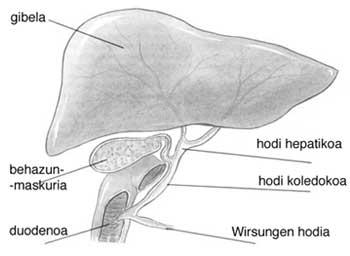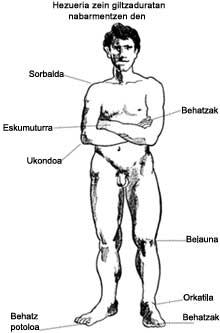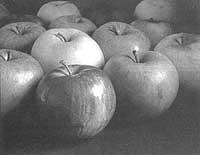Gallstones
1994/04/01 Mugica Aguinaga, Fernando Iturria: Elhuyar aldizkaria
In recent years much progress has been made in the therapeutic field of this disease and in the field of external lithotripsy (an electrohydraulic system produces high-pressure waves that are sent through an ultrasound to the stones until they are broken and destroyed) and laparoscopic cholecystectomy (laparoscope is a device that can penetrate the peritoneum by an incision of two centimeters).
Classical cholecystectomy may in many cases be replaced by these systems (subject to certain requirements). On the other hand, a lot of progress has also been made in the knowledge about habitual evolution.
This disease is widespread and affects three percent of the Western population. Our therapeutic behavior has varied considerably over the years. Most of the first cases were operated (except for high-risk cases), since most of them were ultimately considered complicated.
However, in people without symptoms (even if they are diabetic) we know that there is little chance of pain or other complication (15-20% at age 15-20). That is why they are not treated, except for two exceptions: one is that of those who have porcelain gallbladder (due to its high risk of maleficence, in which cholecystectomy must be performed) and another that of those who have free small stones floating in the bile, since in them bile acids (only ursodeoxylic acid or kenodeoxycholic acid) are used without any danger.
However, after the first pain, most of the time it appears again (70% in two years), although the incidence of complications is low. Therefore, once the pain is started, it should be treated by selecting one of the available methods. For this, we previously classified the cases in two groups (complicated and without complications).

I) In uncomplicated symptomatic patients, any method can be chosen:
- Bile acids
- Extracorporeal lithotripsy
- Cholecystectomy, both classical and laparoscopy.
But keep in mind that if you are over 65, the method of lithotripsy or acid can be used very little.
II) Cases with complications (acute cholecystitis, choledocholithiasis, obstruction of the jaundice, acute pancreatitis, acute cholangitis, chronic cholecystitis) require a method of aggression (classical cholecystectomy or laparoscopy, endoscopic esphinterectomy only with one of them).
Medical treatment, compared to surgical treatment, has its advantages. For example:
- Less contraindications
- Lower morbidity (i.e. unwanted side effects) and lower mortality (almost none).
- Cholecystectomy is effective, safe and economical, with a morality of 0.4% and 5% for children under 65.
It also has its cons:
- No comfort.
- Higher cost and more days of hospitalization (5 days approx. ).
Considering all this, it would be easy to choose, except surgical. However, these few alternatives could be used rarely, since in all of them only 20% are able to take bile acids and only 17-25% of lithotripsy. On the other hand, there is the duration of treatments, since once bile acid is selected, it should be taken for at least 6 months and after 12 months, only 30%-40% total brine is achieved.
However, with lithotripsy, 30% are without stones after the second month and after several attempts at lithotripsy (it must also be taken into account that after lithotripsy you normally have to take bile acids). On the other hand, the gallbladder is abandoned with these methods, so the rate of relapse in the first year with the treatment of bile acids is 12.5% and 61% in the eleventh year, and with the 11% lithotripsy in the first and a half years.

In a study conducted in the United States following a half-million cholecystectomy, it was observed that: In 39%, medical treatment was possible. Some of them were able to treat them with ursodeoxycholic acid and in the rest extracorporeal lithotripsy and auxiliary brine treatment could be used, but nevertheless, in most of this group and in 40% of the ursodeoxycholic acid group, the treatment ended up failing and requiring surgery.
The rest had calcified or pigmentary stones, of collédoco... or had another reason to avoid medical treatment and go directly to surgical treatment.
The current success of cholecystectomy is not surprising if we take all of this into account. Especially if done laparoscopic, since in this way the morbidity and mortality are reduced and the days of hospitalization are scarce (usually less than two days). Other advantages are:
- Virtually no aesthetic spots
- No pain after surgery
- Being able to get back to work soon
- No eventration
- Absence of age discomfort and obesity.
It should be noted that general anesthesia is used and sometimes because the gallbladder does not look good (by adhesions) or because it is very pathological (acute cholecystitis, enpiema, etc.) or because the cirrhotic liver appears (in these cases hemostasis is very difficult to achieve), laparoscopic cannot be performed and a classical cholecystectomy is performed.

Gai honi buruzko eduki gehiago
Elhuyarrek garatutako teknologia





